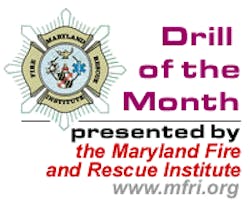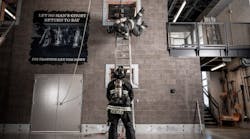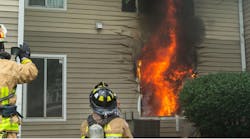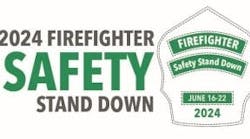TOPIC: DEVELOPING A TRAINING DRILL
TIME REQUIRED: TWO HOURS
MATERIALS: APPROPRIATE AUDIO VISUAL SUPPORT
REFERENCES: FIRE INSTRUCTOR'S TRAINING GUIDE, SECOND EDITION, JOSEPH R. BACHTLER, FIRE ENGINEERING FIRE AND EMERGENCY SERVICES INSTRUCTOR, SIXTH EDITION, IFSTA
PREPARATION:
MOTIVATION:
OBJECTIVE (SPO): 1-1
The individual will demonstrate a basic understanding of what is required to develop and deliver an in-station training drill for a fire or rescue department, from memory, without assistance, to a written test accuracy of 70%.
OVERVIEW:
DEVELOPING A TRAINING DRILL
* Objectives
* References
* Equipment/Materials Needed
* Support Needed
* Evaluation
* Lesson Plan
DEVELOPING A TRAINING PROGRAM
SPO 1-1 The individual will demonstrate a basic understanding of what is required to develop and deliver an in-station training drill for a
fire or rescue department, from memory, without assistance, to a written test accuracy of 70%.
EO 1-1 Identify the elements required to develop training objectives.
EO 1-2 Identify how to determine what reference material may be used to support a drill.
EO 1-3 Identify how to determine what equipment or materials may be needed to support a training drill.
EO 1-4 Identify how to determine the instructional support needed for a drill.
EO 1-5 Identify methods that can be used to evaluate student performance in a training drill.
EO 1-6 Identify how to develop a lesson plan that arranges the instructional material in the proper sequence.
This drill is designed to assist the training officer, instructor, or others who may be called upon to develop and/or deliver a training drill in their fire or rescue department. It is intended that this drill outline will help lay out the drill in a logical sequence and document what is to be taught. In some cases, individuals who are very knowledge in the subject area have been less than successful in conveying information to their audience because they have not presented the material in an organized manner. There may also be a failure to measure the results of the training to determine if it was effective.
I. OBJECTIVES
A. Why Develop Objectives
1. Outline what is to be taught
2. Objectives provide the framework for the teaching outline
3. Document the expected results
4. Provide a frame of reference for evaluating the students
B. Elements of the Objectives
1. Components of an objective
a. Conditions - givens
1) Tools to be used to accomplish the objective
2) Equipment needed to meet the objective
b. Behavior - what will be done
1) Specific
2) Clear
3) Use action verbs
c. Standard - how well it will be done
1) Expected level of performance
2) Acceptable minimum level of performance
2. Quantify and qualify expected results
a. Include relevant measurements such as time
b. Include qualifiable expectations such as level of completion or standard of performance
3. Based on
a. Job analysis
b. Operational need
c. New or changed procedure or policy
4. Includes certain assumptions
a. Activity will be completed properly
b. Activity will be conducted safely
c. Activity will be performed correctly
d. These assumptions should be a given in any training activity and should not need to be included
in the objectives
5. Use key action words
a. Describe - report the essential properties of an object or event
b. Identify - physically select, indicate, or explain an object orally or in writing
c. List - group similar objects or events in a methodical or systematic arrangement
d. Construct - make an object, a verbal statement, or a drawing
e. Demonstrate - show by actual use, illustration, simulation, or explanation
f. Individually - student performs the activity without assistance
g. As part of a team - student performs the activity as part of a team
II. REFERENCES
A. Texts
1. Lesson guide should reference text that are the basis for the training activity
a. Text may serve as the basis for determining if the skill is performed correctly
b. Text may provide sequence for performing a skill
c. Text supports generally accepted practices
2. Text may serve as basis for uniformity in performing skill or providing instruction
B. Standards
1. National standards such as NFPA may provide a basis for the lesson
2. Should be referenced in objectives
3. May outline required performance level
C. Regulations
1. Applicable regulations such as OSHA may outline what is required
2. Should be referenced in objectives
3. May provide legal basis for conducting training
D. May help to determine condition, behavior, and standard
III. EQUIPMENT/MATERIALS NEEDED
A. Overview
1. If the session includes a demonstration, the material or equipment should be available to perform
the demonstration
2. If the session includes hands-on practice by the students, adequate equipment or material should be
available
a. One piece of equipment for each 5 to 7 people
b. If expendable supplies are be used, supplies should be provided for each participant
c. Some means of sanitizing may be required for reusable items where there will be mouth to
equipment contact by more than one person with the same piece of equipment, i.e., manikin
facepieces in CPR training
3. Students may not be able to visualize equipment or materials from a picture--it is better to have the
real thing
4. Equipment and materials should support the lesson rather than the lesson support the equipment or
materials especially visual aids
5. If bulky equipment is being used, break the group down to more manageable components so that
everyone can see and understand
B. Apparatus
1. Identify number and type needed
2. Identify if apparatus must be placed out of service
3. May require standby units
4. Have adequate apparatus to perform the evolutions
C. Equipment
1. Identify what is needed
2. Have adequate equipment in relation to number of participants
3. Make sure equipment is in working order
4. Make sure students know how to use equipment
D. Expendable Materials
1. Identify what is needed
2. Have adequate materials in relation to number of participants
3. Eliminate any safety hazards associated with materials, e.g., removing fuel tanks from automobiles
before performing extrication
E. Structures
1. Safe to use
a. No man-traps (weak areas or openings in floors)
b. Structurally sound
c. Adequate means of exit/escape
2. Environmental considerations
a. Asbestos
b. Floor coverings
c. Exterior wall and roof coverings
3. Fuel load
a. Watch heat generation level
b. Do not use flammable or combustible materials
c. Limit quantity of fuel to that needed to accomplish the lesson (do not see how much can be
generated)
1) Results in unnecessary injury
2) Results in unnecessary damage to personal protective clothing
IV. SUPPORT NEEDED
A. Identify Number of Support Instructors Needed
1. Maintain safe instructor to student ratio
a. Hands-on activities such as vehicle extrication may require one instructor for each 5 to 7
students
b. Practical activities such as live burns may require at least three pair of instructors
1) One pair with students in fire area
2) One pair with the students waiting to enter the fire area (back up team)
3) One pair with the students who have just exited the fire area
4) A safety officer and overall supervisor will be needed
c. Additional instructors may be needed
1) Hot or cold weather
2) Physical layout of training area
3) Level of proficiency of the students
4) So that safety is not jeopardized
2. Identify instructors to students
3. Make instructor assignments
B. Insure Instructors Are Qualified for Duties Assigned
V. EVALUATION
A. Purpose of Evaluation
1. Obtain feedback on instruction
2. Determine if objectives have been achieved
3. Identify deficiencies in student learning
4. Identify deficiencies in training (do not assume that the failure to learn was the student's fault)
B. Evaluation Elements
1. Should be reasonable in relation in terms of what is expected to be accomplished
2. Should be realistic in term of the department's operations policies, and procedures
3. Should be based on generally-accepted practices or procedures
C. Means of Evaluation
1. Written examination
2. Oral quizzing
3. Class interaction
4. Observation of student performance
VI. LESSON PLAN
A. Content
1. Goal
2. Objectives - should be limited to 5 or 6
3. References - may want to cite specific sections
4. Equipment and materials
a. Audio visual aids
b. Audio visual equipment
c. Apparatus
d. Supplies and materials such as straw or excelsior to burn, bandages and dressings, etc.
e. Equipment such as saws, tools, splints, etc.
5. Instructional content
6. Summary
7. Review
B. Structure of Lesson Content
1. Follow a logical presentation sequence
2. Demonstrate skills before expecting students to perform them
3. Address pre-requisite knowledge or skills
4. Utilize group activities to provide an opportunity to demonstrate an understanding of the material
5. Choose the presentation method best suited for the topic
a. Lecture for general presentation of information
b. Demonstration where the student is expected to perform a skill
c. Practical activity where the students have already been provided with the pre-requisite
knowledge and skill
6. Use audio visual materials and teaching aids to support the lesson rather than having the lesson
support the aids
REVIEW:
DEVELOPING A TRAINING DRILL
* Objectives
* References
* Equipment/Materials Needed
* Support Needed
* Evaluation
* Lesson Plan
REMOTIVATION: A well-organized training drill will generate interest among participants and will contribute to the overall efficiency and effectiveness of the department.






